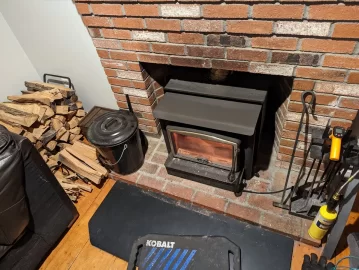Hi All,
For a Vermont Castings Intrepid Flexburn (2115) the install manual states to install a Type I floor protector.
Where is 'Type 1' or 'Type 2' defined? UL1618? NFPA 211 doesn't mention much. IRC neglects to mention this.
NFPA 211:
Some people mention 22ga sheet metal being the minimum ember protection. I assume this number is from individual manuals, but does not necessarily apply to every stove.
If Type 1 is the requirement for floor protection am I forced to buy a UL1618 listed piece of sheet metal? Or, is there an acceptable equivalent defined somewhere? I see other discussions casually dismissing that the sheet metal is fine as Type 1. I'm sure it is more than adequate from an engineering perspective but if I get into an argument with insurance or the inspector I can't cite that...
Thank you!
For a Vermont Castings Intrepid Flexburn (2115) the install manual states to install a Type I floor protector.
Where is 'Type 1' or 'Type 2' defined? UL1618? NFPA 211 doesn't mention much. IRC neglects to mention this.
NFPA 211:
3.3.72 Floor Protector. A noncombustible surfacing applied to the floor area underneath and extending in front, to the sides, and to the rear of a heat-producing appliance.
Vermont Castings Manual:Hearth Protection Requirements FLOOR PROTECTION: It is necessary to install a Type I floor protector.
In the US: The unit may be installed on a combustible floor if the bottom heat shield is installed and non-combustible spark & ember protection is used. The bottom heat shield is required unless the unit will be installed on a completely non-combustible surface (example: unpainted concrete over bare earth). There is no required R or K value. The floor protector should extend 8” (203 mm) from either side of the loading door, 16” (406 mm) from the front of the unit and 6” (152 mm) to the rear of the unit. The floor protector must extend underneath any horizontal run of chimney connector and extend 2” (51mm) beyond each side.
I've seen requirements in other manuals that say you need to use a CONTINUOUS ember protector. I plan on using two big chunks of stone mitered with a line of grout between them. If I laid a strip of metal along that grout line (from the bottom) it would, for all intents and purposes, be sufficient for ember protection. Regardless, I can't find a code requirement stating that it needs to be continuous, and/or that grout is unacceptable.Some people mention 22ga sheet metal being the minimum ember protection. I assume this number is from individual manuals, but does not necessarily apply to every stove.
If Type 1 is the requirement for floor protection am I forced to buy a UL1618 listed piece of sheet metal? Or, is there an acceptable equivalent defined somewhere? I see other discussions casually dismissing that the sheet metal is fine as Type 1. I'm sure it is more than adequate from an engineering perspective but if I get into an argument with insurance or the inspector I can't cite that...
Thank you!


